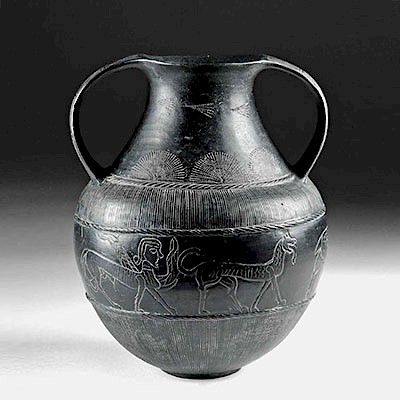18th C. Russian Gilded Icon - Resurrection / Anastasis
Lot 209
About Seller
Artemis Fine Arts
686 S Taylor Ave, Ste 106
Louisville, CO 80027
United States
Selling antiquities, ancient and ethnographic art online since 1993, Artemis Gallery specializes in Classical Antiquities (Egyptian, Greek, Roman, Near Eastern), Asian, Pre-Columbian, African / Tribal / Oceanographic art. Our extensive inventory includes pottery, stone, metal, wood, glass and textil...Read more
Estimate:
$3,400 - $5,100
Absentee vs Live bid
Two ways to bid:
- Leave a max absentee bid and the platform will bid on your behalf up to your maximum bid during the live auction.
- Bid live during the auction and your bids will be submitted real-time to the auctioneer.
Bid Increments
| Price | Bid Increment |
|---|---|
| $0 | $25 |
| $300 | $50 |
| $1,000 | $100 |
| $2,000 | $250 |
| $5,000 | $500 |
| $10,000 | $1,000 |
| $20,000 | $2,500 |
| $50,000 | $5,000 |
| $100,000 | $10,000 |
| $200,000 | $20,000 |
About Auction
By Artemis Fine Arts
Mar 21, 2019
Set Reminder
2019-03-21 10:00:00
2019-03-21 10:00:00
America/New_York
Bidsquare
Bidsquare : Fine Ancient | Asian | Ethnographic Art
https://www.bidsquare.com/auctions/artemis-gallery/fine-ancient-asian-ethnographic-art-3967
Featuring classical antiquities, ancient and ethnographic art from cultures encompassing the globe, plus fine art. Egyptian, Greek, Roman, Etruscan, Near Eastern, Asian, Pre-Columbian, Native American, African / Tribal, Oceanic, Spanish Colonial, Russian, Fine Art, so much more! Artemis Fine Arts info@artemisfinearts.com
Featuring classical antiquities, ancient and ethnographic art from cultures encompassing the globe, plus fine art. Egyptian, Greek, Roman, Etruscan, Near Eastern, Asian, Pre-Columbian, Native American, African / Tribal, Oceanic, Spanish Colonial, Russian, Fine Art, so much more! Artemis Fine Arts info@artemisfinearts.com
- Lot Description
Eastern Europe, Russia, ca. 1750 to 1780 CE. A beautiful, densely iconographic wooden icon with rich painted details and gilt. In the center is a depiction of the Resurrection and the Anastasis (the Harrowing of Hell); surrounding it are scenes from the Old and New Testament. Each scene is labeled around the edges in Church Slavonic written in black ink. These scenes describe the dodekaorton, the twelve great feasts of the liturgical year, alongside four extra scenes that the patron would have chosen. The painting of the panel is of very high quality, and the complex imagery indicates that the patron who commissioned the piece and the artist who painted it both had a strong interest in and an understanding of theology. Size: 12" W x 13.9" H (30.5 cm x 35.3 cm).
The center image shows two main scenes from the life of Christ and several smaller scenes from His life. The first and highest is His Resurrection, where he stands centrally atop his tomb. In the lower left corner is the red, monstrous head of Satan/the Hell Mouth, opened as Christ, again located in the center, leads the Harrowing of Hell, freeing the souls trapped there. The smaller scenes include the Virgin Mary and Mary Magdalene, Peter examining Christ's tomb, doubting Thomas touching Christ's wounds, Christ greeting John the Baptist, and Christ and Peter on the Sea of Galilee in a boat. Numerous witnesses - all named with black paint on their halos - are present, rising diagonally from left to right behind the figure of Christ in Anastasis.
The scenes around the edge show: The Nativity of the Virgin (note the rich architectural setting, showing her family's wealth); The Presentation of the Virgin in the Temple; The Holy Trinity, or the Hospitality of Abraham (from the Old Testament); The Annunciation including God in Heaven; The Nativity of Christ; the Presentation of Christ in the Temple; The Theophany, when Christ was baptized; The Entry of Christ into Jerusalem astride a donkey; The Transfiguration, attended by the prophets Elijah and Moses and the Apostles Peter, John, and James; the Ascension; the Dormition of the Virgin; the Raising of Lazarus; The Beheading of John the Baptist; The Pentecost, which is the second most important feast day in the Orthodox calendar after Easter; the Protection of the Mother of God; and, finally, the Exaltation of the Cross, commemorating the finding of the True Cross by the Empress Helena in 335 CE.
In addition to all of these rich scenes, each corner contains a small tableau of an Evangelist, and in the center top is a scene depicting Father, Son, and Holy Spirit as dove.
See a very similar icon at the Victoria & Albert Museum (number 1159-1864) and in the British Museum (number 1926, 1115.1.).
Provenance: private Ventura County, California, USA collection
All items legal to buy/sell under U.S. Statute covering cultural patrimony Code 2600, CHAPTER 14, and are guaranteed to be as described or your money back.
A Certificate of Authenticity will accompany all winning bids.
We ship worldwide and handle all shipping in-house for your convenience.
#121486Slight age patina on surface, with very small losses to pigment around the edges and some very small nail holes, also around the edges. Pigment and gilding are in nice condition, and all details and letters are clear. Back slats are present and in good condition.Condition
- Shipping Info
-
All shipping is handled in-house for your convenience. Your invoice from Artemis Gallery will include shipping calculation instructions. If in doubt, please inquire BEFORE bidding for estimated shipping costs for individual items.
-
- Buyer's Premium



 EUR
EUR CAD
CAD AUD
AUD GBP
GBP MXN
MXN HKD
HKD CNY
CNY MYR
MYR SEK
SEK SGD
SGD CHF
CHF THB
THB




















